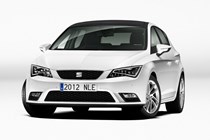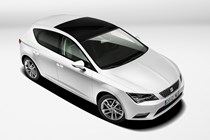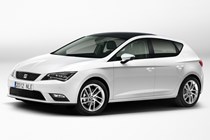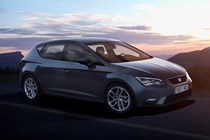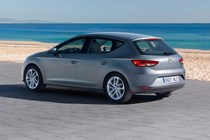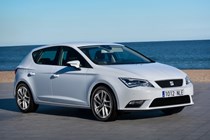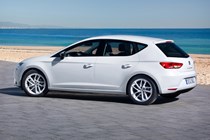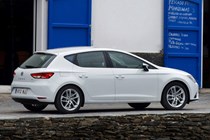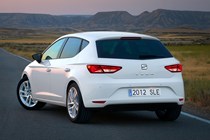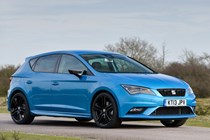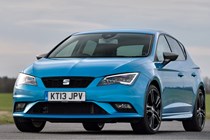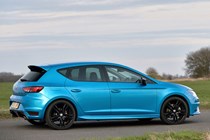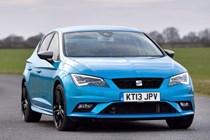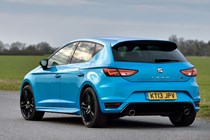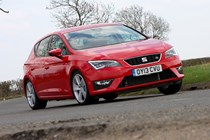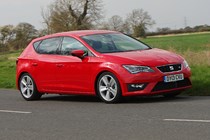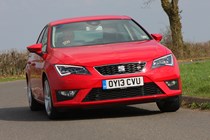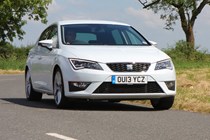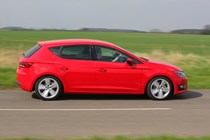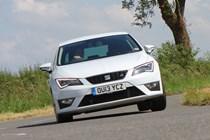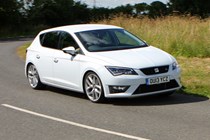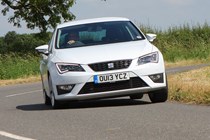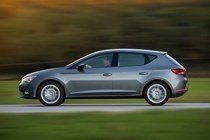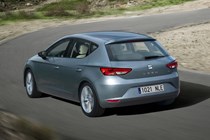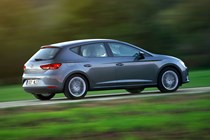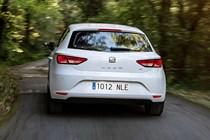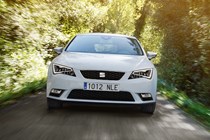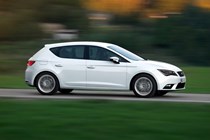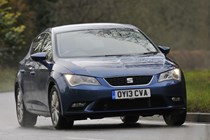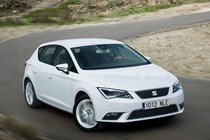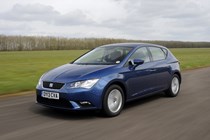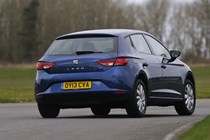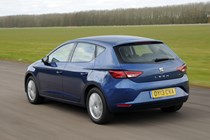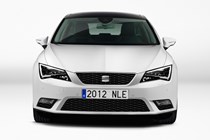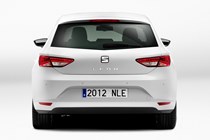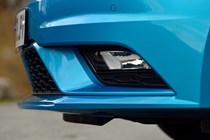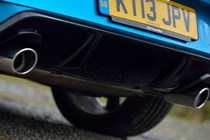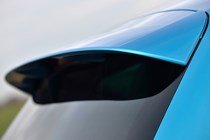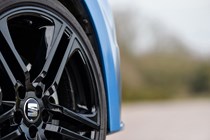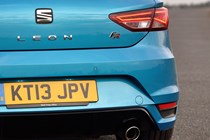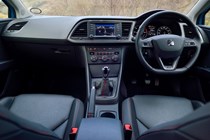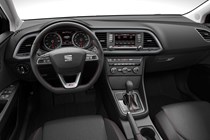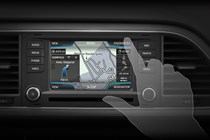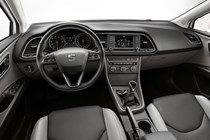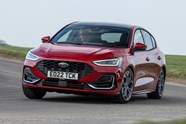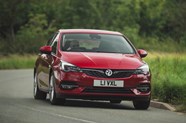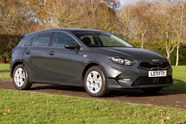
SEAT Leon Hatchback review
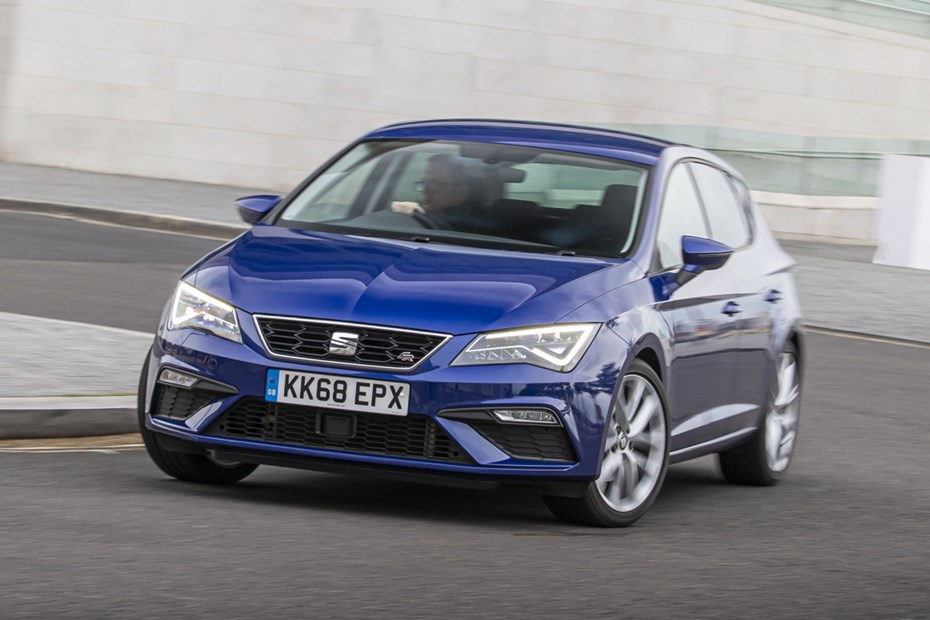
At a glance
| Price new | £15,850 - £34,495 |
|---|---|
| Used prices | £2,800 - £21,072 |
| Road tax cost | £0 - £255 |
| Insurance group | 12 - 36 |
Get an insurance quote with

|
|
| Fuel economy | 35.8 - 58.9 mpg |
| Range | 418 - 858 miles |
| Miles per pound | 5.2 - 7.8 |
| View full specs for a specific version | |
Available fuel types
Petrol
Diesel
Pros & cons
- Most engines are fuel efficient
- But also offer strong performance
- Interior is well-built and well-designed
- High boot lip hinders access slightly
- Touchscreen media system can be fiddly
- Suspension is on the firm side
SEAT Leon Hatchback (13-20) rivals
Overview
The SEAT Leon has always been an appealingly sporty alternative to a Volkswagen Golf. It may have the same high-quality underpinnings, and share the same engines, but the Leon simply looks that bit racier, that bit faster against the clock. It has the everyday pizzazz lacking in a Golf – and, over the years, has earned itself a loyal following as a result.
Indeed, ownership satisfaction surveys show Leon drivers to be a very happy bunch – particularly those who own the sharp-suited 2013-2020 car. This was the best Leon ever at launch, a real step on from its predecessor in terms of refinement, sophistication and overall quality. Buyers even had the option of LED headlights – a world first in the family hatchback sector. The Leon was offered as a core five-door hatch, or a sportier three-door called Leon SC. There was also an estate, called Leon ST.
All Leon of this era are well equipped, with standard air con, touchscreen infotainment, Bluetooth and electric door mirrors. The engines are good, too: 1.6 and 2.0 TDI diesels sold well but the petrols are equally strong, with the 1.4 TSI and later 1.5 TSI proving great all-rounders. Then there’s the more focused driving dynamics of the Leon, which is crisper and more engaging, without going over the top (unless you choose the high-performance Cupra, that is…).
As prices now starting from around £4,000 represent excellent value, you may be thinking of buying one. If you are, here are 10 things to look out for.
SEAT Leon Mk3 known faults and common problems
1. CONDENSATION IN THE REAR LIGHTS
Here’s an easy check to make: look at the rear lights for signs of condensation within the units. The seals frequently leaked, causing water ingress that, if it gets really bad, can lead to failure of the rear lights – making the car illegal to drive (it won’t pass an MOT either). A new rear light unit is around £120.
2. GEAR SELECTION
Manual gearboxes should be silky-smooth, with fingertip-light gear selection across all ratios. Some owners report notchiness in some gears (there’s no real pattern – sometimes it’s lower gears, sometimes it’s the higher ones), which isn’t normal and could be expensive to fix. Make sure the gears change with the finesse they should.
3. DSG SERVICING
The DSG dual-clutch automatic gearbox has its own service regime: cars that have been looked after by SEAT dealers or specialists will have followed this, but those left to the aftermarket may not. Look for evidence the DSG oil and filter have been changed every 40,000 miles, because it’s storing up expensive problems if they haven’t.
4. THE 2017 FACELIFT
A 2017 facelift brought slightly crisper lines and a larger 8.0-inch touchscreen inside. Engines were also upgraded; the 115hp 1.2-litre TSI switched to a 1.0-litre TSI three-cylinder turbo with the same power, and the 1.4-litre TSI became a 1.5-litre TSI Evo. Both are great engines and the latter has active cylinder technology, shutting down two of the four cylinders during light loads to save fuel. Also look out for the 1.6 TDI Ecomotive, which returned official fuel economy of over 80mpg and today benefits from free VED road tax. Saying that, the 1.0 TSI and 1.2 TSI will hardly break the bank, with annual road tax of £30.
5. CUPRA ALLURE
The range-topping SEAT Leon is the high-performance Cupra. This has stiff suspension, a sporty makeover outside and in, plus a potent 2.0-litre TSI engine that originally put out 280hp. In 2015, it was upgraded to 290hp, and reached the 300hp mark in 2017. In the same year, there was also an ultra-rare Cupra R, with 310hp. How rare? Only 24 were sold in the UK…
6. DIFFERENT SUSPENSION
One for the driving enthusiasts, this: the SEAT Leon has different rear suspension, depending on the power output of the engine. Those with less that 150hp have a simpler twist-beam rear end, while more powerful models have a sophisticated multi-link setup. Most won’t tell any difference, but keen drivers may just notice the extra dynamism of higher-power cars, and the greater prowess of the suspension over challenging roads. It really shouldn’t be a deal-breaker, though (and the simpler setup will be cheaper to fix if anything wears out).
7. SAT-NAV MAPPING
If sat nav is fitted (note, having a touchscreen doesn’t guarantee standard satellite navigation), try to work out how recent the mapping is. If it’s not been upgraded, it could be several years out of date – and a new SD card with updated mapping is £150.
8. SPEC CHECK
Base-spec Leon are pretty well equipped, but you might prefer SE grade as this adds alloys and cruise control. Most appealing are the FR and FR Sport grades, which have a racier appearance, rear privacy glass, sports seats, dual-zone climate control and rear parking sensors. There are Teck packs for both SE and FR, which add LED headlights and sat nav. SEAT later introduced a high-grade Xcellence, with even more as standard.
9. SPORTS STYLING KIT
You might notice Leons in the classifieds wearing a distinct styling kit. This isn’t an aftermarket add-on, but an official SEAT accessory. It was comprehensive, with sports bumpers, more muscular side skirts and a bigger rear spoiler.
10. APPLE CARPLAY AND ANDROID AUTO
In 2015, SEAT launched a special Leon Connect variant, with ‘Full Link’ technology that included Apple CarPlay and Android Auto functionality. By 2016, this was standardised across the range.
Read on for our full verdict on the used SEAT Leon hatchback to see if it’s still worth a look over its rivals.




